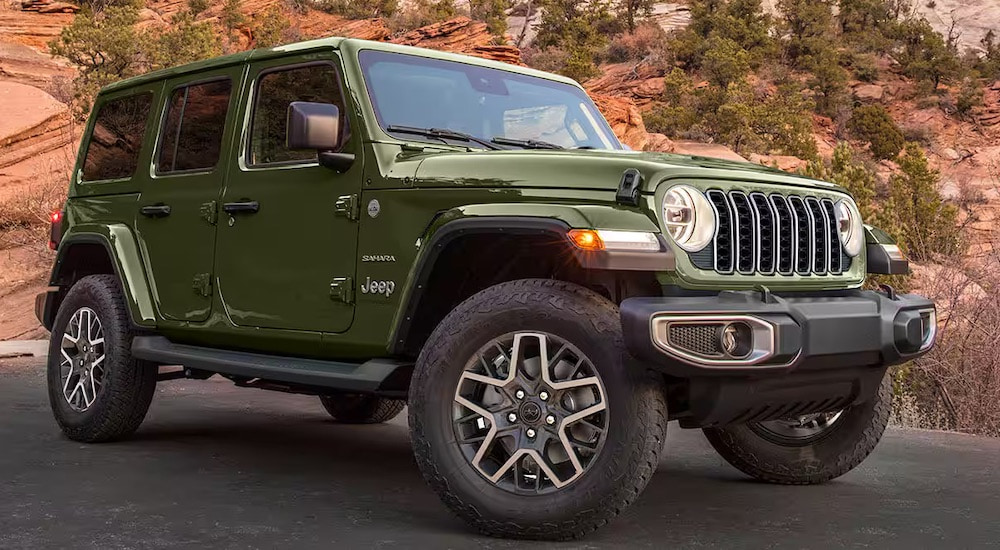From fax machines and typewriters to pagers, floppy disks, and cassette tapes, plenty of examples of outdated technology have rapidly disappeared from the modern market. While there’s always going to be nostalgia for antiquated tech and a few flannel-clad hipsters eager to preach the lo-fi warmth of a cassette or old-world charm of a typewritten letter, most people have come to accept the fact that there will always need to be some sacrifices in the name of progress.
The manual transmission is the exception that proves the rule. Once the go-to method for power transmission, manuals have largely fallen out of fashion as automakers continue to embrace new technology. However, for a certain subset of drivers, there’s simply no substitute for the control, efficiency, and engagement a manual can offer. When did today’s SUVs start to lose their manual options, what’s behind the trend, and what sort of perks are drivers missing out on as the market transitions to embrace new technology? We’ll explore all that and more as we trace the recent history of the manual transmission.
The End of the Manual
Manual transmissions are quickly becoming an endangered species, especially in the SUV segment, where there are currently just two manual options for 2025. The old-school transmission peaked in the 1980s with up to 35 percent of new vehicles leveraging a manual gearbox, but that number has since fallen as low as one percent as drivers and automakers turn to new options. It’s not just SUVs, either. Cars and trucks have also been shedding their manuals at an unprecedented rate as automatic transmission, especially ultra-efficient continuously-variable transmissions (CVTs), continue to make gains. The increasing lack of manual options can be tied to the rising popularity of all-electric vehicles, which largely rely on a new breed of single-speed transmissions to transfer power, but these aren’t the only factors to consider.
Development costs and regulatory pressure also come into play, with governments pushing strict efficiency guidelines that make vehicles with manual transmission a little harder to justify. One of the biggest challenges facing the manual might be simply a lack of familiarity. Learning to drive a stick used to be a rite of passage for young drivers, but as manuals steadily disappear from the market, it’s becoming harder and harder to find someone who can instruct you on the intricacies of the clutch, rev-matching, and changing gears. Finally, there’s the steady and inevitable march of progress. Today’s cars are more automated than ever, with drivers relying on adaptive cruise control, automatic high-beam headlights, and other advanced driver-assistance systems (ADAS) like lane-keeping assist and automatic emergency braking to handle most busy work. In a market where we’ve gone so far as to outsource basic braking and accelerating duties to an automated system, asking drivers to work three pedals and a stick shift to change gears is a little ambitious.
According to J.D. Power, the popularity of the old-fashioned transmission reached an all-time low in 2021, with just 0.9 percent of gearboxes employing the manual approach. That number has since risen to 1.7 percent, but manual transmissions still constitute a real minority in today’s auto market. The Honda Civic hatchback, Jeep Gladiator, Kia Forte, Mini Cooper, and Volkswagen Golf GTI and Golf R all lost their manuals for the 2025 model year. While there have been some notable exceptions to the trend, they’re largely limited to performance-minded models like the Toyota Supra, Acura Integra Type S, Porsche 911, a bevy of BMWs, and Cadillac’s V-Series models. The Ford Mustang and Mazda Miata have also retained their manuals for 2025, while the Nissan Versa and Mazda 3 hatchback represent two of the more budget-friendly options. The Toyota Tacoma is the last remaining pickup to carry the manual torch with its six-speed option, which shows just how far the tech has fallen in a segment where manuals once ruled the road.
Last of a Dying Breed
That brings us to the SUV segment, where, as of 2025, the list of manual options has been whittled down to two specific models. One is a longstanding leader in the off-road segment with over 80 years of history to back up its go-anywhere reputation, while the other is a recently revived model that effortlessly combines modern tech with classic SUV style. Both have made a manual transmission an inexorable part of their automotive DNA. This is a rarity at a time when, in an effort to grow the off-road segment, brands are increasingly dumping manuals to flatten the learning curve and attract new buyers. The Jeep Wrangler and Ford Bronco are the last manual holdouts, which makes each SUV worthy of a closer look.
Jeep Wrangler
Jeep earned its off-road stripes on the battlefields of WW2-era Europe, providing a rugged, dependable troop transport that gave the Allies a marked advantage in the lengthy conflict. The Jeep Wrangler might have only hit the market in 1986, but it represents the culmination of decades of hard-earned experience through the CJ line, which evolved directly from wartime models. Jeep has slowly pruned its manual offerings over the years, with the Gladiator pickup being the most recent model to lose the option, but it’s hard to imagine the Wrangler will ever follow suit.
The 2025 Wrangler’s six-speed manual transmission is uniquely suited to off-road use, providing better control and power than an automatic to allow Jeep drivers to overcome challenging terrain and obstacles. The manual also opens the door to engine braking, when a driver downshifts to help control their speed when descending a steep hill. The ability to choose a specific gear can make all the difference when the going gets rough, allowing the Wrangler to ascend an acute incline, power through loose surfaces, and free itself from some sticky situations.
Ford Bronco
The 2025 Ford Bronco stands as the only other SUV on today’s market with a manual option. It goes a long way towards providing what drivers are missing out on as the industry turns to automatic alternatives. This SUV has seen a lot of changes since it first hit the streets in 1966, transitioning from a compact to a full-size and finally a midsize model with the debut of the sixth-generation model in 2021.
One thing that hasn’t changed is the Bronco’s manual transmission. Ford knew that if it wanted the resurrected Bronco to compete with the Wrangler, a manual transmission was a must-have, so it teamed up with Magna Powertrain to grace the SUV with a seven-speed Getrag manual transmission. While the manual is limited to Broncos outfitted with the base 300-hp, 2.3L I-4 engine, its very existence is an encouraging sign at a time when manual options are few and far between. The Getrag manual isn’t your normal seven-speed transmission, but a six-speed with a dedicated “crawler” gear designed to maximize traction in extreme off-road conditions. In addition to lending the Bronco plenty of low-end power, the seven-speed manual is less prone to overheating and cheaper to repair should something go wrong.
What Does the Future Hold?
Is there room for the manual transmission in today’s market? How will the technology fare as the industry pushes towards the future? The rise of EVs would seem to spell the end for the manual transmission, but that’s not necessarily the case. As long as gas-burning engines exist, the manual will always have a place in the market. Some EVs have begun experimenting with a hybridized approach designed to encompass the best of both worlds. Even the first-generation Honda Insight was available with both a CVT automatic and a five-speed manual transmission.
Honda and Toyota have already developed novel systems that simulate the manual experience while embracing the inherent advantages of the single-speed design. These models use electronic switches, software, clutch pedals, and steering-wheel-mounted shifters to mimic a manual, while Porsche and Audi employ a two-speed automatic with manual shifting for their Taycan and e-Tron GT models. Jeep has even gotten in on the action with a concept EV version of the Wrangler that uses a six-speed manual, but such systems have yet to find their way into a full production model.
This sort of technology holds some promise, but in all likelihood, future manuals will probably be limited to high-end sports cars, dedicated off-roaders, and other niche models. High research and development costs, low demand, and an increasing lack of familiarity have conspired to kill the manual. The SUV segment will never see the manual saturation it once enjoyed. While this might irk some stick shift purists who put a premium on rowing their own gears, the manual will largely be seen as a victim of continued engineering progress. That said, plenty of pre-owned vehicles, including a wide array of SUVs, still allow drivers to enjoy the manual approach. If you’ve always been curious about a manual, or are simply the sort of rebel that likes to zig when everyone else is on their zag, it might be time to seek out a new manual-equipped Jeep Wrangler or Ford Bronco while you still can.





